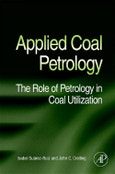This book is an integrated approach towards the applications of coal (organic) petrology and discusses the role of this science in the field of coal and coal-related topics.
Coal petrology needs to be seen as a continuum of organic (macerals) and inorganic (minerals and trace elements) contributions to the total coal structure, with the overprint of coal rank. All this influences the behavior of coal in utilization, the coal by-products, the properties of coal as a reservoir for methane or a sequestration site for carbon dioxide, and the relationships of coal utilization with health and environmental issues.
The interaction of coal properties and coal utilization begins at the mine face. The breakage of the coal in mining influences its subsequent beneficiation. Beneficiation is fundamental to the proper combustion of coal and is vital to the preparation of the feedstock for the production of metallurgical coke. An understanding of basic coal properties is important for achieving reductions in trace element emissions and improving the efficiency of combustion and combined-cycle gasification. The production of methane from coal beds is related to the properties of the in situ coal. Similarly, coal bed sequestration of carbon dioxide produced from combustion is dependent on the reservoir properties. Environmental problems accompany coal on its way from the mine to the point of utilization and beyond. Health aspects related with coal mining and coal utilization are also included because, in planning for coal use, it is impossible to separate environmental and health issues from the discussion of coal utilization.
The book is aimed at a wide audience, ranging from researchers, lecturers and students to professionals in industry and discusses issues (such as the environmental, and health) that are of concern to the general public as a whole.
Please Note: This is an On Demand product, delivery may take up to 11 working days after payment has been received.
Table of Contents
1. Introduction2. Basic factors controlling coal quality and technological behavior of coal
3. Mining and benefication
4. Coal combustion
5. Coal gasification
6. Coal liquefaction
7. Coal carbonization
8. Coal-derived carbons
9. Coal as a Petroleum Source Rock and Reservoir Rock
10. Environmental and health aspects
11. Other applications of coal petrology








